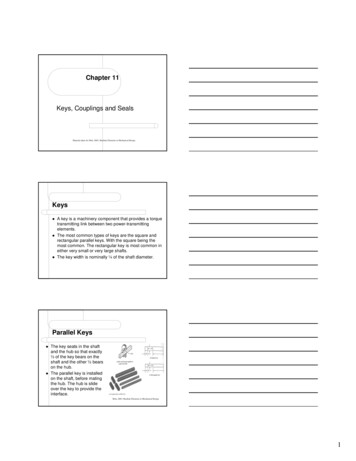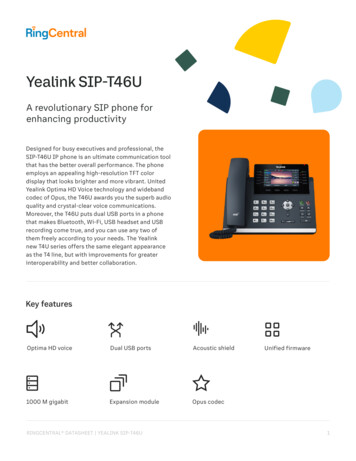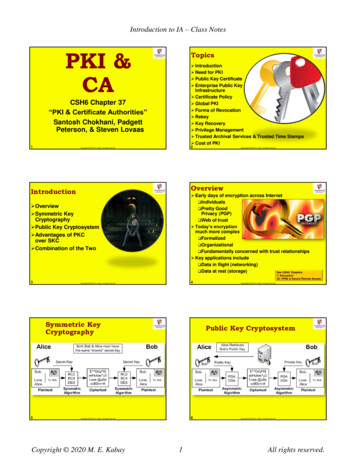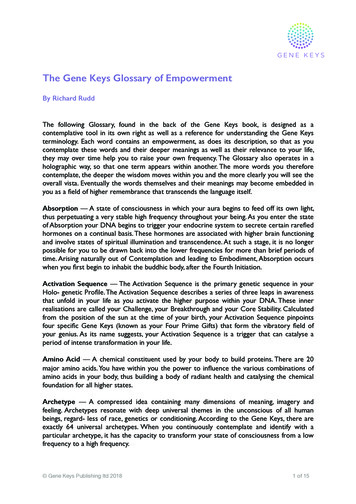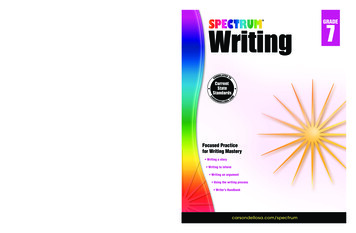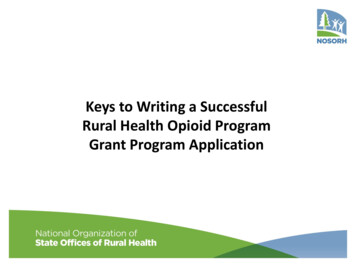
Transcription
Keys to Writing a SuccessfulRural Health Opioid ProgramGrant Program Application
Michael BlodgettMichael is a Public Health Analyst at the Federal Office ofRural Health Policy within the Health Resources andServices Administration. He is the Program Coordinatorfor the Rural Opioid Overdose Reversal grant program andthe Rural Health Opioid Program. Prior to joining HRSA,Michael was a Peace Corps Volunteer in Cambodia and anEmergency Medical Technician in Henrico County, Virginia.
Teryl EisingerTeryl has more than 20 years experience in health care and has worked extensively inthe areas of rural health and health promotion for underserved populations. Terylserved as assistant director of the Nevada Office of Rural Health and the NortheasternNevada Area Health Education Center before being named NOSORH executive director.Throughout her career, Teryl has had programmatic responsibility for variousInterdisciplinary Training, State Loan Repayment, Rural Health Outreach, AbstinenceEducation and other federally funded programs. She has provided volunteer leadershipto various rural and urban non-profit organizations whose missions focused oneconomic development and rural health, including serving as chair of a largecommunity health center. Teryl received her undergraduate degree in allied healthmanagement from Northern Arizona University and holds a Master of Arts degree fromthe University of Nevada-Reno. She has also taught communication, marketing andbusiness skills courses at Great Basin College.Chris SalyersChris Salyers joined the NOSORH team as the Education and Services Director inFebruary 2016. Previously, Chris served as a Rural Project Manager with the KentuckyOffice of Rural Health where he handled workforce activities, office communicationsand publications, network activities and special projects. Prior to that, Chris heldpositions with the Northeast Kentucky AHEC, local community coalitions and with aregional Community Mental Health Center. Chris holds a Bachelors and Masters inCounseling from Morehead State University in Morehead, Kentucky, and is currentlypursuing a Doctor of Health Sciences (DHSc) from A.T. Still University.
Rural Health Opioid Program(RHOP)Federal Office of Rural Health PolicyHealth Resources and Services AdministrationDepartment of Health and Human ServicesMichael Blodgett, Program Coordinator
Purpose to promote rural health care services outreach by expandingthe delivery of opioid related health care services to ruralcommunities with the goal of reducing rates of morbidity andmortality related to opioid overdoses in rural communities.
Objectives Identify: Identify individuals at-risk of overdose and guide them towardsrecovery by providing outreach and education on locally availabletreatment options and support servicesEducate the Community: Educate community members on opioid usedisorder, treatment options and methods for preparing and referringindividuals with OUD to treatmentCoordinate Care: Implement care coordination practices to organizepatient care activitiesSupport Recovery: Support individuals in recovery by establishingnew or enhancing existing behavioral counselling and peer supportactivities
Program Summary Funding Opportunity Title: Rural Health Opioid Program (RHOP) Funding Opportunity Number: HRSA-17-022 Due Date for Applications: July 21, 2017 Anticipated Total Annual Available FY17 Funding: 3,000,000 Estimated Number and Type of Award(s): Up to 12 grant(s) Estimated Award Amount: Up to 250,000 per year Cost Sharing/Match Required: No Project Period: September 30, 2017 through September 29, 2020 (three (3) years) Eligible Applicants: Rural public or rural non-profit private entities that represent consortiums composedof 3 or more health care providers. Authority: Public Health Service Act, Section 330A(e) (42 U.S.C. 254(c)(e))
Timeline Posted to Grants.Gov: 6/15/2017 NOSORH TA Webinar: 7/6/2017 FORHP TA Webinar: 7/13/2017 Application Due Date: 7/21/2017 Review Dates: 8/15/2017-8/16/2017 Project Award Date: 9/12/2017* Project Start Date: 9/30/2017** These dates are subject to change.
ContactMichael BlodgettProgram Coordinator, Rural Health Opioid ProgramFederal Office of Rural Health PolicyHealth Resources and Services Administration(301) 443-0144mblodgett@hrsa.gov
What you are going to hear & see: Answer 10 key questionsbefore making thedecision to apply for thisfunding. Describe successfulstrategies to write a RuralHealth Opioid Programgrant application. Identify resources tosupport the grantapplication effort. Grant writing tips Some samples Some things thefunder may or maynot be able to share!
Rural Health Opioid ProgramThanks toFederal Officeof RuralHealth Policy!MikeBlodgett,Public HealthAnalystProject Purpose:The purpose of the RHOP Program is to reduce themorbidity and mortality related to opioid overdoses in ruralcommunities through the development of broad communityconsortiums to prepare individuals with opioid-use disorder (OUD)to start treatment, implement care coordination practices toorganize patient care activities, and support individuals in recoveryby establishing new or enhancing existing behavioral counseling,peer support, and alternative pain management activities.This program will bring together non-profit entities suchas hospitals, primary care practices, substance abuse, treatmentcenters, social service organizations, and other community groupsto respond with a multifaceted approach to the opioid epidemic ina rural community. The program will support three (3) years offunding with the primary goal of demonstrating improved andmeasurable health outcomes, including but not limited to, reducingopioid overdose morbidity and mortality in rural areas.
Assumptions:You understand that NOSORH is not thefunding agency . FORHP is the expert on thisapplication process!You have personally read every word of theguidance for this opportunity! Footnotes Background ResourcesYou plan to listen & ask questions on theFORHP webinar !You might need:– some help deciding whether to apply– some direction on how to get asuccessful application together– additional resourcesFORHP Webinar Day & Date: Thursday, July 13, 2017Time: 2:00 – 3:00 p.m. ETCall-In Number: 1-888-790-1893Participant Code: hop technical assistance/Playback Number: 1-866-501-0093
What is the National Organization of StateOffices of Rural Health?The National Organization of StateOffices of Rural Health promotes thecapacity of State Offices of Rural Healthto improve health care in rural Americathrough leadership development,advocacy, education, & partnerships.Grant writing educationWeb-based:Rural Health Grant Writer InstituteGrant Writing Beyond the BasicsEMS Grant Writing InstituteOn site:Upon Request
Role of State Offices of Rural Health State Office of Rural Healthin every state in the nation Every State Office of RuralHealth is unique Roles:– Informationdissemination– Coordination– Technical assistanceApplicants are required to notifythe State Office of Rural Health(SORH) of their intent to apply tothis programA list of the SORHs can beaccessed rowse-by-state/.* Applicants must includeAttachment 2 State Office ofRural Health Letter.
10 generic “pre-grant application” questions1.2.3.4.5.6.7.Who will write the application?What is the problem you are trying to solve?What data do you have to document the problem?What partners can help you meet the needs?What exactly do you want to do about the problem?Who will do the work required by the grant?What will you have after you have finished that youdon’t have now? How can you measure that benefit?8. Can you sustain the work after grant funding?9. How much will it cost?10. What are your chances of being funded?
Who will write the application?Are you registered to submit a grant inGrants.gov & current?Are youeligible & ableto submit agrant?The applicant organization must be a state,public or private non-profit entity located in arural area or in a rural census tract of anurban countyVerify applicant EIN Number is rural per theHRSA sorOne exception for prison populationcommunities see pp 4-5*Provide evidence of public or private nonprofit status - in Attachment 1Funding must be used for programs whichserve population residing in a HRSAdesignated rural area Verify !
Who will write the application?Point guard usually the fastestplayer on the team, organizes theteam's offense by controlling the ball& making sure that it gets to theright player at the right time.Writer(s)Support se your talent wisely!
The Project AbstractStart it! WORK it! OverviewPurposeGoalsActivitiesExpected benefits tothe target population Unique qualification ofthe consortium andapplicant Funding preferenceSee Sample
Who will write the application?CONSORTIUM MEMBERS MEETINGDRAFT AGENDAWalk through the guidance – purpose,funding, requirementsShare draft project abstract, & rough budget& goalsFocus on the guidancemajor sectionsoutside team helpGain commitmentAsk the hard questions- what do they bring to the project ?- who will staff report to ?- who will get funds – for what - indirect?Summarize with the 10 questions.Make assignments including due dates.Commitments: Endorsement Staff for the grant writing team Data Organization information What benefit to their work Signature on MOU?What more do they need toknow?Don’t forget to make assignments forthe attachments.pp. 16-18Use the 10Seequestions?
What are your chances of being funded?Only 12 applications will be funded.Could be less!Unlikely to be funded if the applicationdoes not have a VERY high score.Broadly defined definitions of healthcare providers (p. 1 and p. 31)FUNDING PREFERENCEQualification 1: Health Professional Shortage /ShortageDesignationAdvisor.aspx.Qualification 2: Medically UnderservedCommunity/Populations /ShortageDesignationAdvisor.aspxQualification 3: Focus on primary care & wellness &prevention strategies.This focus must be evident throughout the projectnarrative.*Funding preference request must be included in theProject Abstract.* Proof of meeting funding preference (screenshot)& a statement of eligibility must be included inAttachment 12
What are your chancesof being funded?Write to the reviewers.Follow the narrativeoutline.Pp 8-19Need 25%Response 25%Evaluative Measures 15%Impact 15%Resources & TA Capacity 10%Support Requested 10%
Writing for the review – it isn’t easy!Narrative SectionReview CriteriaPointsAttachmentWhat you write & the order inwhich they read it.What they “score”.Project Abstract(separate from the narrative)ALLN/AYESIntroduction(1) Need25 ptsN/ANeeds Assessment(1) Need25 pts#4 Service Area MapMethodology(2) Response25 pts#10 Sustainability Plan#11 Evidence Based Practice AbstractWork Plan(2) Response &(4) Impact25 pts15#5 Work Plan (including timeline)Resolution of Challenges(2)Response25 ptsN/AEvaluation &Technical Support Capacity(3) Evaluative Measures &(5) Resources/Capabilities15 pts#8 Baseline Measures#9 Preliminary Evaluation PlanOrganizational Information(5) Resources/Capabilities10 pts#3 (3 parts) Applicant Org Chart &Consortium Org Chart (with listing) &MOU#6 Staffing plan & Job descriptions (1 p.)#7 Bio SketchesBudget & Budget Narrative(6)Support Requested10 ptsYESWhat they also look at when they “score”.10 pts
Criterion # 1 Need – 25 pointsUnmet health care needs related to opioid abuse, treatment, & recovery - that theconsortium proposes to address.document the need in the proposed service area.Sections InNarrative:Introduction p. 8Needs Assessmentpp. 8-9Include a description of the target population:a) Estimated size of the target population (not just the at-risk population)b) Number of counties that will be served (rurality, HPSA designations)c) Demographics of the target population (age structure, poverty, insurance)d) Incidence of opioid overdoses (& other incidence & prevalence data)e) Morbidity & mortality rates related to opioid overdosesf) Previous and/or current efforts to address opioid overdoses within the target population(especially by members of the consortium including treatment & recovery)Review Scoring:Pages 8-9 & 21-22Key challenges & barriers related in the service area include geographic, socio-economic,linguistic, cultural, ethnic, workforce or other barriers that prohibit access to substance abuse& recovery servicesIdentify differences in access, service use, & outcomes for the target population incomparison with the general population in the state or region. (how are the needs of yourtarget population unique?)Describe the number & types of service facilities & providers. Use a map!Describe the consortium (& their organizational needs) identify members that will addresstreatment, recovery.
Local data Use data from the members of your consortium:– Discharge data– Utilization data from human resource agencies, faithbased organizations, schools & others– Local survey results Weave in qualitative data:– patient, family or provider, public safety or EMSstories– focus group or community meeting quotes– key informant interview quotes
Mapping Tools UDS Mapperhttp://www.udsmapper.org State Health Access Data Assistance Center(SHADAC): State Health Compare (state level)http://statehealthcompare.shadac.org MapChart - free simple map creatorhttps://mapchart.net
Possible State Data Sources CDC Opioid Overdose database State Office of Rural Healthhttps://www.cdc.gov/drugover State Health Departmentdose/opioids/index.html State Hospital AssociationNational Center for Health State Licensing BoardsStatisticshttps://www.cdc.gov/nchs/ Substance Abuse and MentalHealth Data Archivehttps://www.samhsa.gov/data/ County Health Rankings &Roadmaps (*note location oforiginal data)
FINDING STATISTICS & DATARELATED TO RURAL d-data
County Health Rankings & Roadmaps
U.S. Census Bureau QuickFacts
SAMHSA Service Area Need for OpioidTreatmentOhio 2016 Potential Areasfor Addressing Service Gapsfor Opioid TreatmentData Sources:Drug Use: NSDUH (2012)Facilities: SAM HSA (2016)Population: ACS 5-year average (2010-2014)https://www.samhsa.gov/data/mat mapOptimal AreasQuintile 5Quintile 4Quintile 3Quintile 2Quintile 1Non-Optimal AreaRoadsState BoundaryCounty Boundary
What level is the data?UDS MapperLocalStateXXFederalCDC’s OpioidOverdose DatabaseXXSHADAC StateHealth CompareXXNational Center forHealth Statistics(need to analyzeown data)XXXSubstance Abuseand Mental HealthData ArchiveXXXCounty HealthRankings andRoadmapsXXX
Need – Write for the reviewer Your job show them thatthe need is so critical theymust recommend yourproject for funding. They .might calculate a“per target population”cost for your project. They will judge yourconsortiums’ capacitywhen they read the needstatementAre the problems youdescribe the sameproblems & FORHP wantsto address?
Criterion #2 Response – 25 pointsSections InNarrative:Methodology p.10Work Plan p. 11Resolution ofChallenges p. 12Evaluation pp. 1213Review Scoring:pp. 22-233 Parts Methodology – Strategy Work Plan – Processes Resolution of ChallengesWhen it seems redundant to another section – don’tskip it. Summarize, give the basics, don’t use the samewords from another section, reference the othersection.
Criterion #2 Response – 25 pointsSections InNarrative:Methodology p. 10Work Plan p. 11Resolution ofChallenges p. 12Evaluation pp. 12-13Review Scoring:pp. 22-23METHODOLOGY part 1- Propose methods meet the program purpose strategy and rationale Define the specific activities & strategies that will be implementedare aligned to accomplish the project goals outlined in theIntroduction and performance measures outlined in the Evaluation& Technical Support section and proposed in Attachment 8. Explain how the project will benefit the target population, overcomeexisting challenges & barriers to treatment & recovery services Describe how they will collect & analyze data (including the datacollection system), assess program effectiveness, & makerecommendations for improving program effectiveness. (In general– reference to the section) Identify potential barriers & challenges to forming the consortium &implementing activities along with possible solutions to address thebarriers & challenges. (Be strategic!) Preliminary sustainability plan that includes factors & strategies thatwill lead to viability & sustainability after federal funding Attachment10 Information on evidence based frameworks , innovation s & creativeapproaches. If portions of the proposed methodology are based on aproject that had prior results, describe that program & how it will beapplied & adapted to this project. Include an abstract in Attachment11.
A word about sustainability Scale back? Income generationo Consultingo Fee for service Contributions/Sponsorshipo Social/Civico Business Events Adoptiono Governmento Faith basedSee SampleRural Health Information HubRead other projects’ plans – see sample
Criterion #2 Response – 25 pointsSections InNarrative:Methodology p. 10Work Plan p. 11Resolution ofChallenges p. 12Evaluation pp. 12-13Review Scoring:pp. 22-23WORK PLAN part 2 - Describe the process that will be used to accomplishthe methodology – who’s on first?Work Plan outline of goals, objectivities & activities & the responsible partyincluding a timeline for all 3 years. Attachment 5. Narrative on: roles, shared responsibilities, & collaboration, integrationinto individual organizations & evidence of their capacity, leveraging ofresources with local, state, regional and federal partners to accomplishgoals and avoid duplication. Include a separate timeline within thisnarrative for the phases for each of the 3 years. Provide the consortium’s communication plan to be implemented forupdating participating entities on work plan progress, evaluationmeasures, & other activities. Include the approach, frequency ofmeetings, & communication tools used by the consortium and rationalefor this plan. Description of data collection, analysis sharing and monitoring measuresfor effective performance & quality assurance/quality improvementstrategies . Explain how results & data of the project, will be shared regionally ornationally including platforms to be used to share the successes & lessonslearned from your program. Describe how the proposed project may be replicable in othercommunities.
Goal check! Goals are GENERAL– Are your goals stated as a result of what you wantaccomplished to address the need? Objectives are OPERATIONAL– Specific? Measurable? Achievable? Relevant? Timely? Can the progress of your project be measuredaccording to quantifiable assessments? Is it clear who is responsible?
Example of Goals & ObjectivesGoal: To provide comprehensive access to care tocancer patients in Central Alabama including theindigent, underinsured and uninsured patients whocannot afford comprehensive care as prescribed bytheir doctor.Objective: To increase access to transportation tochemo or radiation appointments for at least onethousand indigent, underinsured and uninsuredcancer patients within one year.
PROPOSED Work Plan – 3 YEAR WORK PLANGOAL I:Objective edCompletionPIMSMeasureProcess or Outcome MeasuresLong Term Impact
Criterion #2 Response – 25 pointsSections InNarrative:Methodology p. 10Work Plan p. 11Resolution ofChallenges p. 12Evaluation pp. 12-13Review Scoring:pp. 22-23RESOLUTION OF CHALLENGES part 3 - Discuss challengesthat are likely in designing & implementing the activitiesdescribed in the Work Plan, & approaches that will beused to resolve such challenges.History is evidence.Be strategic.
Response – Write for the reviewer You .show them you knowhow to plan, implement,sustain & share the resultsof a project that willincrease treatment &recovery options & reduceOUD morbidity & mortality. They will judge yourconsortiums’ strategicthinking, managementcapacity & ability to useevidence/data.Reminder .be sure and includeevaluation, sustainability &required reporting requirementsin the work plan! Pp. 27-28
Criterion # 3 Evaluative Measures –15 pointsSections InNarrative:Evaluation andTechnicalSupportCapacity pp. 1213Review Scoring:p. 23See SampleEVALUATION AND TECHNICAL SUPPORT CAPACITY – measures the consortium’sprogress towards achieving the desired outcomes and describes how progress towardmeeting goals will be tracked, measured, evaluated, and communicated – Plan to usedata to quantify, qualify, communicate and make decisions to ensure –you do what yousaid you were going to do – make adjustments as needed and can tell othersdifferences can be attributed to projectIdentify baseline measures which align with the Work Plan and program purpose sothat the consortium can articulate the outcomes of their project by utilizing thesebaseline measures.Describe the process they will use to create a robust evaluation plan and how existingresources and capabilities within both the lead organization and other consortiummembers contribute to the evaluation.Include 9 FORHP baseline AND additional baseline measures identified in Attachment8 and in the work plan.Preliminary evaluation plan is provided in Attachment 9 which is feasible and strongaddresses process and outcome measures, includes evaluation questions to beanswered, describes data sources, targets of outcome measures and how data will becollected, analyzed, communicated and acted upon by the consortium to inform andimprove program development activities and services.Should you consider contracting out the evaluation component?
Writing the evaluation planDescription of what you will do tomeasure the results of the project andits impact on the purpose. Questions to be answered? Who has responsibility? What data will be collected? Why are you collecting this data? When will the data be collected? Bywhom? How? How will it be analyzed? How and to whom will it bereported? How and who will act on it?
Evaluative Measures – Write for thereviewer Your job show that youcan use data to makedecisions about theproject, document thestory about the goodwork & lessons learned,expand the knowledgebase about what worksfor OUD treatment &recovery.
Criterion #4 Impact – 15 pointsSections InNarrative:Work Planp. 11IMPACT – dissemination of project results, and the extent to which resultsmay be national in scope, and the degree to which the activities arereplicable, and sustainability of the program beyond the federal funding.Not to be confused with “impact measures”. ReviewScoring:p. 23 Replicable in other communities with similar needs.The feasibility and effectiveness of the proposed approach for widelydisseminating information regarding results of the project.Explain how information about your program will be shared regionallyor nationally, including efforts by grassroots, faith-based or communitybased organizations. Describe the medium or platforms by which youwill share the successes and lessons learned from your program.The extent to which the applicant’s targeted outcome measures alignwith the proposed objectives and the consortium’s capacity to carry outthe activities in the Work Plan to reach these outcomes.
Impact – Write for the ReviewerEasy 15points!Your job “demonstrate” that theconsortium can come together toaddress OUD and that you areskilled at sharing results & lessonslearned to inform others howtreatment & recovery programs canstart & grow. State conferences,associations, nationalaffiliations (faith basedbodies, membershipassociations, grass rootsorganizations) CADCA – Community AntiDrug Coalitions of America National Families in Action(NFIA) Social media, media,newsletters, OUDprofessionalsConsider adding a communication/information dissemination flow chart of internaland external communication. Keep it simple!
Criterion # 5 Resources/Capabilities10 pointsSections InNarrative:EvaluationTechnical SupportCapacity &OrganizationalInformationPp 12-14RESOURCES/CAPABILITIES - The extent to which project personnel arequalified by training and/or experience to implement and carry out the project.The capabilities of the applicant organization and the consortium members. Review Scoring:p. 24 Organizational chart for the applicant organization & an organizationalchart for the project consortium, with a listing of all the consortiummembers. Attachment 3Provides a clear and robust staffing plan Attachment 6 that includes theroles, responsibilities, and qualifications of staff & consortium members.Consortium members have the capacity to achieve the goals of theprogram.Existing resources & capabilities within both the organization & otherconsortium members for data collection and analysis.Applicant has the financial & administrative management systems in placeto manage the award.The value and expertise each member is able to bring to the consortium.Memorandum of Agreement or Memorandum of Understanding signedand dated by all participating organizations. Attachment 3Project Director (1.0 FTE) will be in place to oversee the daily functions andcoordination of activities within 120 days of the award date.
Resources/Capabilities:Write for the ReviewerYour job ”prove” theapplicant & theconsortium canaccomplish the work planto improve recovery andaddiction services,manage the grant funds &reporting & share theresults & lessons learned,widely.The best proofof abilities istrack record!
Resources/CapabilitiesLead sentence for first paragraph .about the applicant the applicant has the a) management capacity, b)financial systems c)management systems, d) leadership, e)staffing, and f) successful track record to ensure thesuccessful implementation of the project.Write a paragraph or more about each area of expertise.Do the same for the each of the consortium members.See Samples
Criterion #6 Support Requested –10 pointsSections InNarrative:pp. 15-16 &SF 424ApplicationGuideReviewScoring:p. 24Criterion 6: SUPPORT REQUESTEDThe reasonableness of the proposed budget for each yearof the three-year project period in relation to theobjectives, the complexity and the anticipated results. The extent to which the proposed budget isreasonable in relation to the objectives, thecomplexity of the activities, and the anticipatedresults. The extent to which the proposed budget isreasonable in relation to travel, equipment, and legalservices. The budget justification logically documents how andwhy each line item request (such as personnel, travel,equipment, supplies, information technology, andcontractual services) supports the goals and activitiesof the proposed grant-funded activities over thelength of the three-year project period. The extent to which key personnel have adequatetime devoted to the project to achieve projectobjectives.
Budget strategies & mistakesStrategiesMistakes Partners agree on plan Partners are subcontractors as feasible Document how/why youplan to use contractor Leadership isn’t budgeted Doesn’t match work plan Evaluation is left out Not budgeting requiredtravel Rounding
Budget NarrativeLead sentences“Funds of are requested to support a 1.0 FTEProject Director to oversee all aspects of theprogram includingservice delivery, consortiumrelationsand ensuring all reporting requirementsare met. Salary based on .”“Travel funds of are requested to provide travelto the required grantee meeting. Costs arecalculated based on county travel policies andinclude x for air fare, x per day for per diem, x forlodging for 2 travelers for 3 days in Rockville,Maryland.”
Budget: Write for the ReviewerYour job. to make surethat reviewers can readthe budget and knowwhat you plan to do andthat you have theproject managementcapacity to do it!Reminders:3 year budgetRequired travelUnderstand indirect costs
The application packet 80 page limit 16 attachments plus theproject abstract, budgetjustification approximately 55 pages or lessto provide all the other details
Writing a grant budget is likehaving a babyIt will give you thebluesIt might keep you upall nightYou will clean upothers’ messesIn the end it will makeyour life meaningful!
Program Summary Funding Opportunity Title: Rural Health Opioid Program (RHOP) Funding Opportunity Number: HRSA-17-022 Due Date for Applications: July 21, 2017 Anticipated Total Annual Available FY17 Funding: 3,000,000 Estimated Number and Type of Award(s): Up to 12 grant(s) Estimated Award Amount: Up to 250,000 per year Cost Sharing/Match Required: No

